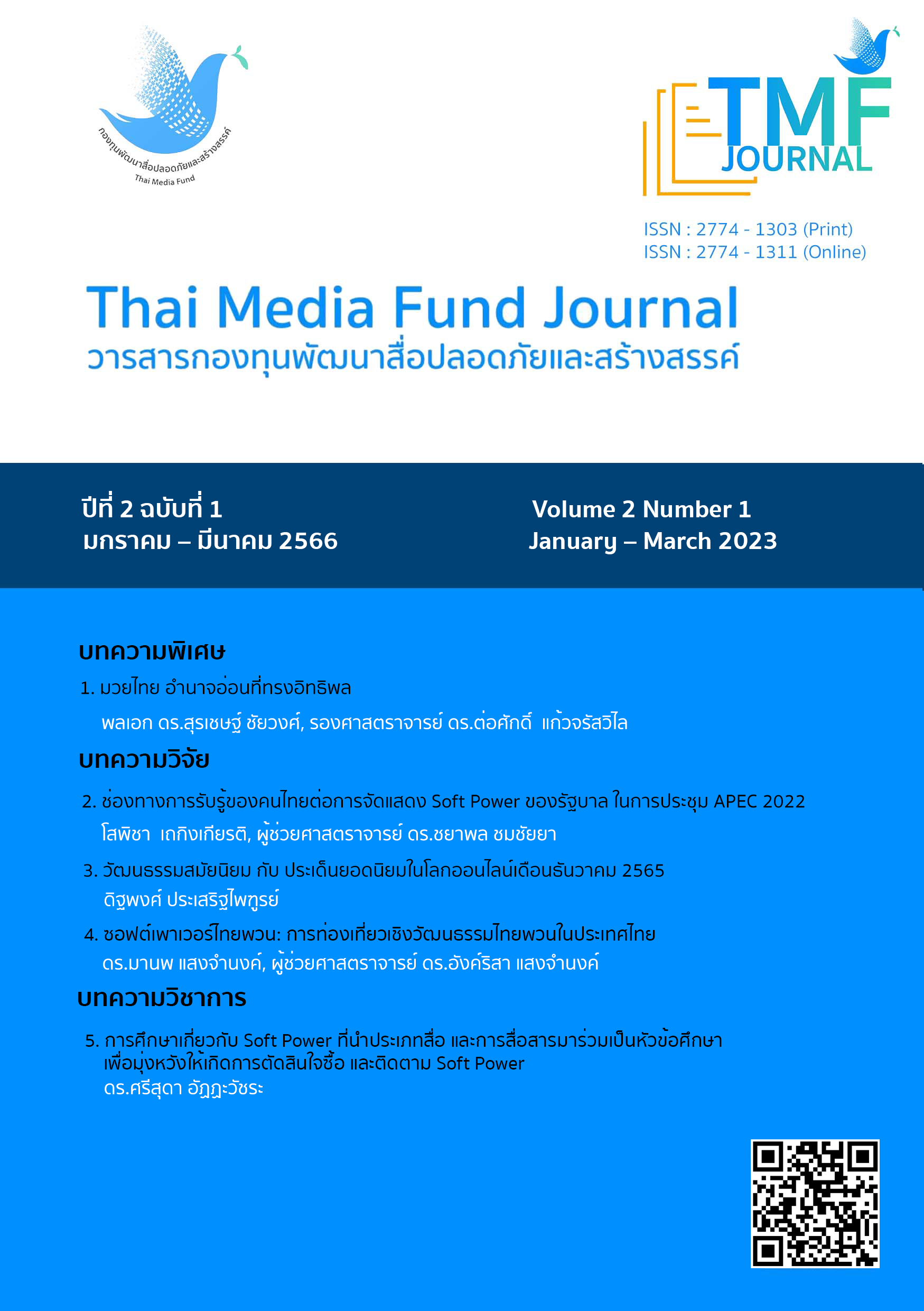ซอฟต์เพาเวอร์ไทยพวน: การท่องเที่ยวเชิงวัฒนธรรมไทยพวนในประเทศไทย
Main Article Content
บทคัดย่อ
การศึกษาเพื่อสรุปอัตลักษณ์และเอกลักษณ์ของวัฒนธรรมไทยพวน สู่การพัฒนาเป็นมรดกเชิงวัฒนธรรมในบริบท พหุวัฒนธรรมของประเทศไทย การศึกษาสรุปเป็น 10 เรื่อง/ตอน ที่มีการเผยแพร่มรดกทางวัฒนธรรมไทยพวน เพื่อส่งเสริมภาพลักษณ์ความเป็นไทยผ่านศิลปวัฒนธรรมไทยของชาวไทยพวน ได้แก่ 1) ความเป็นมาของชาติพันธุ์ไทยพวน 2) ความเป็นอยู่ของกลุ่มชาติพันธุ์ไทยพวน 3) การทำกินแบบไทยพวน 4) ไทยพวนวิถีพุทธ 5) ประเพณีชาวพวน 6) สารท (ความเชื่อและสิ่งลี้ลับกับวิถีชีวิตของชาวไทยพวน) 7) ศิลปะชาวพวน 8) กินอย่างไทยพวน 9) ดนตรีพวนและการแสดงไทยพวน และ 10) การแต่งกายไทยพวน และได้ใช้การสัมภาษณ์ 20 นักท่องเที่ยวเชิงวัฒนธรรมในแหล่งท่องเที่ยวของวัฒนธรรมไทยพวน โดยนักท่องเที่ยวมีความเห็นต่อการพัฒนา Soft Power เพื่อยกระดับการรับรู้วัฒนธรรม การฟื้นฟูมรดกวัฒนธรรม และสร้างคุณค่าในการอนุรักษ์มรดกทางวัฒนธรรมไทยพวน ผ่านแนวคิด 4A 2R Model ที่มีต่อทั้ง 10 เรื่อง/ ตอน โดย Agenda (A1) พบว่า ทั้ง 10 เรื่อง/ ตอน แสดงถึงความเป็นเอกลักษณ์และอัตลักษณ์ทางวัฒนธรรมไทยพวนได้ชัดเจน Actor (A2) และ Action (A4) พบว่า ความร่วมมือ การสนับสนุนและการจัดการ
ให้บรรลุเป้าหมาย ยังไม่เพียงในการดำเนินการด้วยเห็นว่ากลุ่มเป้าหมายไม่เพียงพอ Asset (A3) พบว่ามีการนำเสนอที่มีความชัดเจนในเสน่ห์ทางวัฒนธรรมไทยพวนมากขึ้น ส่วน Reaction (R1) พบว่า ยังมีการตื่นตัวและติดตามในเรื่อง Soft Power น้อยมาก และ Result (R2) พบว่า ยังขาดความชัดเจนในการกำหนดเป้าหมายผลการตอบรับ และการศึกษาเสนอแนะว่า ควรสนับสนุนการศึกษาความเป็นเอกลักษณ์และอัตลักษณ์ทางวัฒนธรรมไทยพวนที่ทรงคุณค่าต่าง ๆ ที่นับวันมีแต่จะลบเลือนไป ด้วยการให้ส่วนงานต่าง ๆ ร่วมกันกำหนดนโยบาย การสนับสนุน ส่งเสริมและให้ความสำคัญกับการอนุรักษ์มรดกทางวัฒนธรรมนั้นๆ ไว้เพื่อไม่ให้สูญหายไป พร้อมเสนอแนะแนวทางในการจัดทำสื่อหรือ วิดีโอที่เหมาะสมต่อไป
Article Details

อนุญาตภายใต้เงื่อนไข Creative Commons Attribution-NonCommercial-NoDerivatives 4.0 International License.
เอกสารอ้างอิง
Bhakdechakriwut, Y., et al., (2016). The Phuan People and the Integrated Cultural Tourism Promotion Strategy. The Journal of Social Communication Innovation, 4(1), 18-32.
Buarapa, A. (2019). Patterns and Factors Remain of Vernacular Landscape "Residential" Khammouane Province, Lao PDR. Journal of Architecture, Design, and Construction of Faculty Architecture, Urban Design and Creative Arts, Mahasarakham University, 1(1), 10-22.
Chuchat, C. (2016). Changes in Beliefs in Raising Chao Pho Pu Ta Ghosts: A Case Study of the Thai Puan People, Ban Hua Krasang Community Chachoengsao Province. An Independent Study, Master Degree of Department of Anthropology, Faculty of Archeology, Silpakorn University.
Department of Cultural Promotion, Minister of Culture. (2016). Culture Lifestyle and Wisdom. Bangkok: Rungsilp Printing. (in Thai)
Duke, P., & Sarigaputi, N. (1986). Local history of the Lao Wiang and Lao Phuan people in Phanom Sarakham District and Sanam Chai District, Chachoengsao Province. Thai Studies Project, Chulalongkorn University.
Kamsuwan, P., et al., (2021). Folk Plays of Thai Phuan Ethnic Groups Related to Well-being Promotion in Thailand. Journal of Social Science and Buddhistic Anthropology, 6(9), 280-293. Concepts for the study of musical identity.
Lopattananon, T. (2022) 4A 2R and Soft Power Explanation as a Power Process. Retrieved from http://www.ias.chula.ac.th/article/4a-2r.
Masiri, P. (2016). The concept of studying musical identity. CONNEXION Journal of Humanities and Social Sciences, 5 (1), 146–165
Mattayomnant, W. (2020). Offering Dance of Thai Phuan Ethnic Group: A Case Study in Mabplakhao Sub-district, Thayang District, Phetchaburi Province.
Nassauer, A. & Legewie, N.M. (2019). Analyzing 21st Century Video Data on Situational Dynamics—Issues and Challenges in Video Data Analysis. Soc. Sci., 8(100), 1-21, doi:10.3390/socsci8030100 www.mdpi.com/journal/socsci
Panin, O., & Chantaweera, N. (2012). Home and House of Phuan People in Xieng Kwang: the Resettlement in the Same Area. Bangkok: Usakane.
Rodkhanmuang, U., & Nesusin, S. (2021). Phuan Singing of Thai Phuan Ethnic Group in Ban Phue District, Udon Thani Province. Journal of Fine and Applied Arts, Khon Kaen University, 13(1), 158-174.
Rotchanasiri, S., et al. (2021). History and Musical Characteristics of Lam Puan Folk Song in Khok Pip Sub-district, Si Mahosot District, Prachin Buri Province. Music and Performing Arts Journal, 7(2), 32-44.
Singkham, W. (2022). The Study of Culture and Tradition of Thai puan : A Case Study of Ban Thanon Kea Subdistrict, Mueng District, Lopburi Province. RMUTL Journal of Business Administration and Liberal Art, Rajamangala University of Technology Lanna, 7(1),15-25.
Singsawat, P. (2018). The Status of Phuan Language Studies. Chophayom Journal, 29(1), 475–486.
Srimok, P., & Kangwan J. (2019). Ethnic food culture documentary film #02. (2019) Princess Maha Chakri Sirindhorn Anthropology Centre (Public Organisation)
Viengsima, M. (2020). Fabric Patterned Design Based on Tai Phuan and Tai Yuan Jok Weaving Art and Wisdom in Line with Creative Economy. Journal of Fine and Applied Arts, Khon Kaen University, 12(1), 127-151.
Wangboonkongchana, T. (2022). Introduction: Building Soft Power. Retrieved from https://www.matichon.co.th/article/news_3310760
Wiratkorn, N., Phrakrukowitatthavadhi, Khonwong, S., & Seanbor, B. (2016). The Study of the Belief and Principle of Buddhadhamma Appeared in Kampha Tradition of Thaipourn Community, Thonghoung Village, Thonghoung Sub-district, Muang District, Phrae Province. Academic MCU Buriram Journal, 1(2), 27–37.
Wiriyawit, N. (2022). Communication of Thai Phuan Ethnic Identity Through Community Product and Packaging of Pakplee Distict, Nakhon Nayok Province According to the King’s Philosophy. Phranakhon Rajabhat Research Journal, Humanities and Social Sciences. Bangkok, Thailand.


